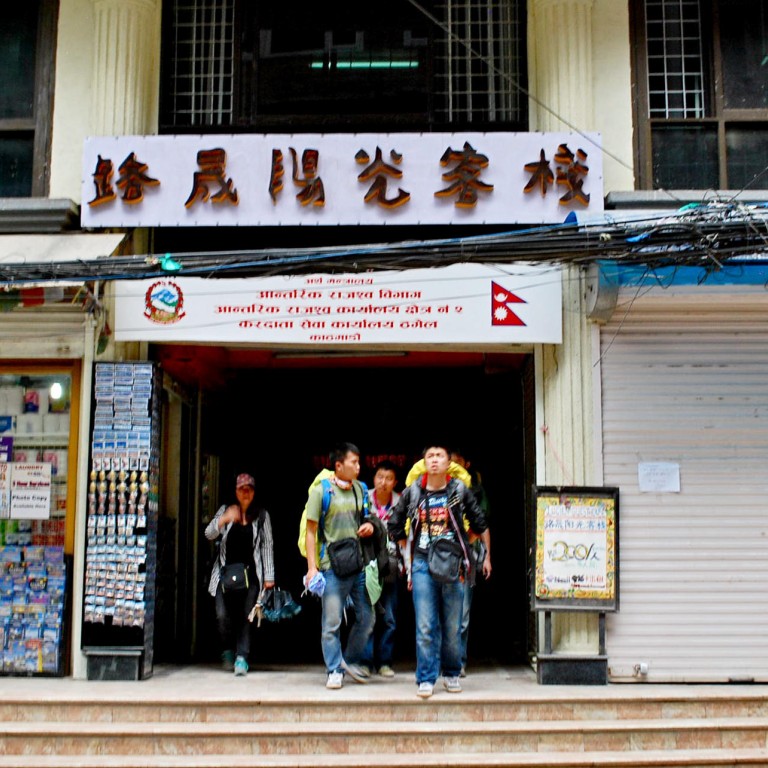
Kathmandu area cashes in on Chinese tourist surge
Restaurants, hotels and even a hospital in the capital's Thamel district offer services to visitors from the north, in their own language
The south side of Kathmandu's tourist hub of Thamel has transformed itself into a cluster of Chinese commerce - restaurants, hotels, travel agencies, shops and even a hospital in this backpackers' haven are strictly targeting Nepal's northern neighbours.
With the country's tourism scene dominated by the influx of Chinese tourists lately, businesses targeting them are also mushrooming. The street that borders the tourist district with the traditional neighbourhood of Jyatha is a prime example.
This stretch of street is crowded with signs in Chinese: Hotels offer their room rates and services, restaurants display their menus and travel agencies plaster their windows with itineraries strictly in the script that would attract their targeted customers.
"It's very helpful," said Kelly Ren, a Chinese tourist visiting Kathmandu with a group of friends. "It's easier to go around and find what you want - it minimises the language barrier."
One of the newest Chinese restaurants has made an effort to set up an authentic ambience. While Putonghua-speaking Nepali staff members approach their guests with menus in their local language, the flat-screen television on the wall is set to a Chinese channel.
A couple of blocks away from this moderately priced restaurant, Ramesh Bishwokarma has opened a small eatery that specialises in cuisine from Sichuan province .
"About 80 per cent of my customers are Chinese," said Bishwokarma, who opened the New Chong Qing Wei Fast Food Restaurant last September. "With so many Chinese tourists coming to Nepal, I thought it would be best to run a Chinese restaurant. And it's doing really well."

"We should be happy that new businesses are being opened to cater to a specific group of tourists," he said.
"Thamel is full of businesses - having more facilities catering to Chinese in this area doesn't mean it's being converted into Chinatown."
While businesses are cheering over the sunny side, cultural enthusiasts travelling to the Himalayan republic say they are missing out on the Nepali experience.
Vito Chow, 24, from Hong Kong said he was disappointed to see the growing market catering to Chinese tourists.
"I'm in Nepal, and I want to get away from all this," he said. "I want to experience local culture and tradition. I can find all this stuff back home."
However, Chow agreed that the businesses might help overcome Chinese tourists with difficulties in communicating in English. Lately, there has also been a surge in Nepalis learning to speak Putonghua.
"There's a demand for it," said one of Bishwokarma's employees who speaks average Putonghua, as he took an order from a customer.
Chow, though dissatisfied, noted that being a Chinese-friendly destination would help draw more tourists for Nepal.
We should be happy that new businesses are [catering] to a specific group
And that's what the country is vying for. "We're trying to fetch in as much [Chinese tourists] as possible," said Aditya Baral, a spokesman for the Nepal Tourism Board.
The latest figures released by the Immigration Office at Kathmandu's Tribhuvan International Airport show that Chinese tourists increased by 25.7 per cent in June compared with the same month last year.
The surge resulted from the Approved Destination Status, a bilateral tourism agreement between China and Nepal in 2001, Baral said. Direct air service linking Kathmandu to Kunming , Guangzhou, Chengdu and Hong Kong has further aided in bringing more tourists.
Baral said an estimated 85,000 Chinese visited Nepal last year mainly for sightseeing, religious and soft-adventure tourism.
He added that the country aimed to increase the number to 100,000 by 2014.

